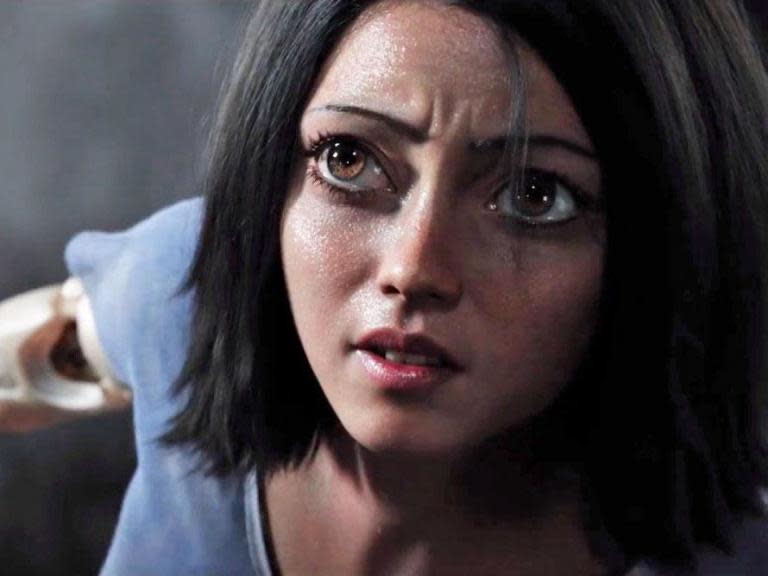Alita: Battle Angel review – Dystopian sci-fi movie produced by James Cameron lacks the emotional pull of Titanic or Avatar
Dir: Robert Rodriguez; Starring: Rosa Salazar, Eiza González, Jennifer Connelly, Mahershala Ali, Christoph Waltz. Cert 12A, 121 mins
James Cameron originally intended to direct Alita: Battle Angel himself but eventually left the task to Robert Rodriguez. Cameron produced and co-scripted it instead. It’s a very curious and contradictory affair: a dystopian sci-fi movie based on a Japanese manga series that is brutal one moment and plays like Disney’s Pinocchio the next. It is undeniably spectacular but is so full of visual effects that its actors risk seeming redundant and you wonder why it wasn’t made as an animation.
Alita herself is a welcome change to the macho heroes generally found in cyberpunk sci-fi movies. “Cupcake” or “little flea” as she is nicknamed, she looks like a teenage version of one of those big-eyed, ingenuous heroines found in Hayao Miyazaki’s animated features.
The film opens in 2563, “300 years after the fall.” It is set in Iron City, a seething but shabby metropolis that sits below a massive sky city called Zalem. Christoph Waltz plays Dr Dyson Ido, a scientist first seen picking through a huge scrap heap, looking for robot parts he can salvage. It’s here he finds the head of a female cyborg and realises she is still alive. Her brain is “miraculously intact”. He takes her home, provides her with prosthetic body parts and christens her Alita.
Played appealingly by Rosa Salazar, Alita is very much the innocent abroad. We see her looking at herself in the mirror, trying to piece together her own identity. She may be a cyborg but she is a delicate and very sensitive one who can express emotion (we see her crying) and who has a healthy appetite, even if she does eat the peel on the orange.
Early on, the film shapes up like a cross between a teen movie and a gothic horror picture. One moment, Rodriguez shows us Alita roller skating, playing pick-up games of Iron City’s favourite sport “motorball” with her new human friends. The next, the shadows fall. A Jack the Ripper-like serial killer is on the prowl.
Waltz’s character isn’t quite the gentle Gepetto-like father figure he first appears to be. He has links with Zalem. He’s a vigilante who goes out after dark with a huge hammer-like object he uses to try to smash rogue cyborgs to pieces. We encounter his former wife, fellow scientist Dr Chiren (Jennifer Connelly), and learn about the child they had together. Dr Chiren is working with the sinister, absurdly named Vector (Mahershala Ali).
The film isn’t helped by the very anodyne romance between Alita and Hugo (Keean Johnson), a blandly good-looking, leather-clad street hustler who becomes her protector and mentor. “It’s a harsh world,” he advises her at one stage. “The strong prey on the weak down here. You’ve got to stay focused on your dream.”
In her pyjamas, sleeping in the cosy bedroom Dyson has made up for her, Alita looks harmless. In fact, as we soon discover, she is one of the most advanced warrior cyborgs ever created. She has an appetite for havoc and carnage.
Certain scenes here – for example, a mass brawl in a bar in which Alita takes on an army of bounty hunters – could come from one of Robert Rodriguez’s Sin City sci-fi noir movies. With their robot dogs and yakuza swords, these cyborg bounty hunters are tough and mean. The most flamboyant, narcissistic and malevolent, who dresses as if he is in a post-punk band, is Zapan (played by Ed Skrein with a strident cockney accent).
The film’s best moments tend to be its most surrealistic ones, when characters have their eyes gouged out or their robotic arms and legs ripped off, or when cyborgs keep on talking, even after their heads have been decapitated. The fight scenes, chases and very violent motorball games are staged with plenty of energy. There are intriguing, elliptical flashbacks as Alita tries to remember the events which led to her being abandoned on the scrap heap in the first place. With her perfect skin and enormous eyes, she may look like a cartoon figure but she is the most expressive character in the film. It’s a little dismaying to see an actor of the quality of Mahershala Ali playing someone who is little more than a cardboard cut-out B-movie villain.
Seen in IMAX and in 3D, Alita: Battle Angel is perfectly serviceable huge screen escapism. However, it doesn’t have anything like the emotional pull of Cameron’s Titanic or Avatar. It struggles as much as Alita herself to work out its own identity and ends up in a no man’s land between animation and live-action, kids’ movie and dystopian sci-fi. It concludes a little abruptly too. We will have to wait for the sequel (if there is one) to find out what really goes on in the mysterious sky-city of Zalem.


